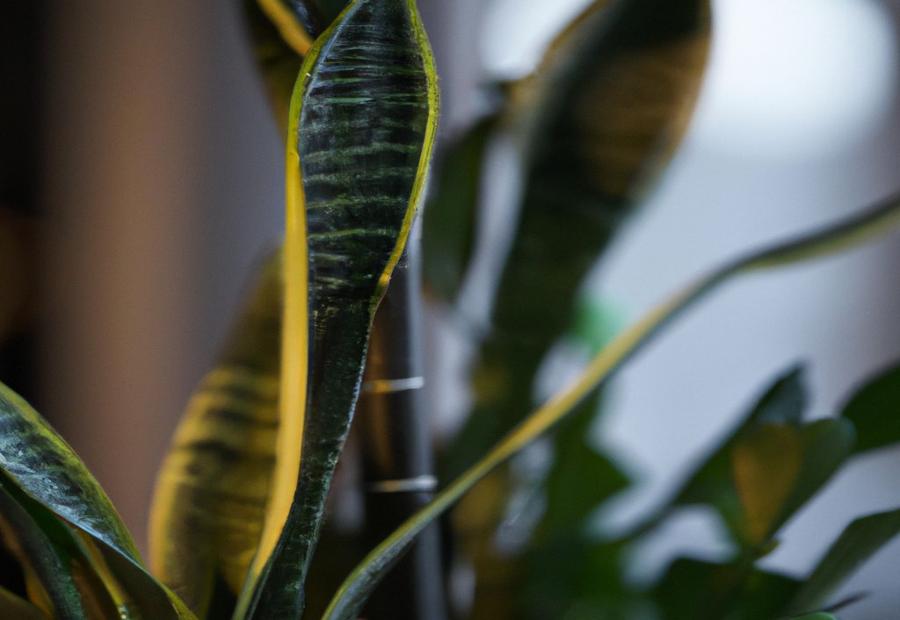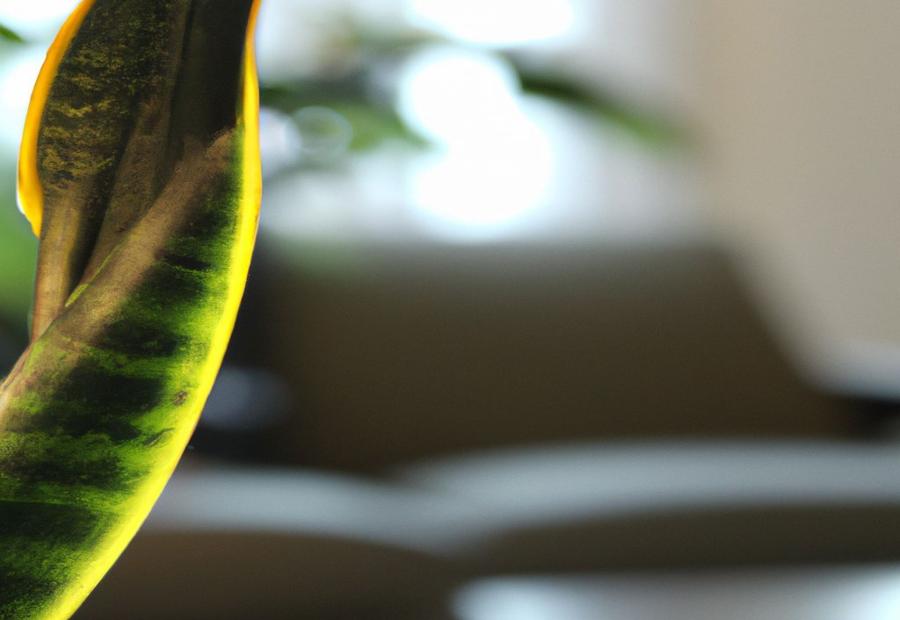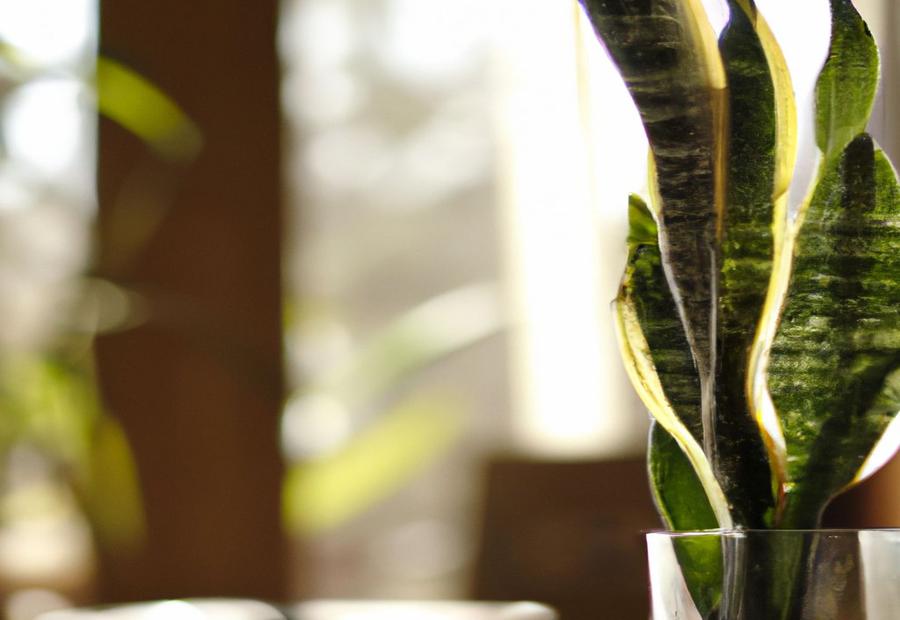Snake plants, also known as Sansevieria, are popular houseplants known for their hardiness and ability to thrive in various conditions. While snake plants naturally have an upright growth habit, sometimes they can start to lean or grow in a crooked manner.
If you want to ensure that your snake plant grows straight and maintains its aesthetic appeal, there are several factors to consider and techniques to implement. By understanding these principles, you can maintain the health and beauty of your snake plant.
In this article, we will explore the importance of growing snake plants straight, the factors that affect their growth, techniques to make them grow straight, common mistakes to avoid, and additional tips for keeping snake plants healthy. Whether you are a beginner or an experienced plant enthusiast, this article will provide you with the necessary guidance to keep your snake plants looking their best.
The Importance of Growing Snake Plants Straight
The importance of growing snake plants straight cannot be overstated. This crucial aspect is vital for their overall health and appearance. When snake plants grow in a straight manner, they receive adequate sunlight. Moreover, it prevents leaves from overlapping or shading each other, ensuring optimal light exposure for every leaf. Additionally, straight growth promotes proper air circulation, which plays a significant role in reducing the risk of moisture-related diseases. By allowing air to circulate freely, the chances of fungal or bacterial growth are minimized.
Straight plants also have better structural integrity. This means they are less likely to experience breakage or leaning. Their strong and upright posture contributes to their resilience and longevity. When snake plants grow straight, they can achieve their full potential in terms of height and spread. This enhances their decorative value, making them an excellent addition to both indoor and outdoor spaces.
Achieving straight growth requires proper care and maintenance. Providing the plant with appropriate lighting is essential. Snake plants thrive in bright, indirect light, so it’s crucial to place them in well-lit areas. Regular watering and ensuring well-draining soil are also essential for their healthy growth.
Regular inspections are necessary to identify any signs of leaning or bending. If detected, providing necessary support can help promote straight growth. This can be done using stakes or ties to keep the plant upright and prevent any further leaning.
By prioritizing straight growth, snake plant owners can enjoy not only a visually pleasing addition to their home or garden but also a healthy and vibrant plant. The beauty and vitality of a straight-growing snake plant are not something to be taken lightly. Therefore, it is crucial to provide the necessary care and attention to ensure their straight growth and overall well-being.
Factors Affecting the Growth of Snake Plants
Curious about what factors can influence the growth of snake plants? Let’s dive into it! In this section, we’ll uncover the secrets behind how light, watering, temperature, soil, and pot size can impact the growth and development of your snake plant. But that’s not all! Brace yourself for fascinating facts and handy tips that will help you understand and optimize each of these elements for the straightest and healthiest snake plant growth. Let’s get started!
Light
Light is an essential factor for the growth and development of snake plants. These plants thrive in bright light conditions. They require even exposure to sunlight to maintain their health and achieve proper growth. Snake plants should be placed in areas where they can receive sufficient sunlight, such as near a window or in a well-lit room. Uneven exposure to sunlight may result in stunted growth or leaves that lean towards the light source.
It is important to note that snake plants can tolerate lower light conditions, but they may grow at a slower pace. If you have limited access to natural light, you can supplement with artificial lights, such as fluorescent grow lights, to provide the necessary light intensity for the plants.
When considering the lighting needs of snake plants, it is crucial to avoid direct sunlight, especially during the hottest part of the day. Direct sunlight can cause the leaves to burn or damage the plant. Partial sun or indirect light is the ideal condition for snake plants to thrive.
To ensure the best growth and health of your snake plants, it is important to provide them with the proper amount and quality of light. This will help them maintain their vibrant appearance and contribute to a healthy indoor environment.
Snake plants have been cultivated for centuries due to their resilience and decorative appeal. Native to West Africa, they were introduced to Europe in the late 18th century. These plants were popular additions to Victorian-era households, known for their ability to thrive in low-light conditions and purify the indoor air. Today, snake plants continue to be cherished for their beauty and easy-care nature, making them a beloved choice for both beginner and experienced plant enthusiasts.
Watering
When it comes to watering snake plants, it is important to consider a few key points:
- Overwatering: Snake plants are prone to root rot if their soil remains wet for too long. It is important to avoid watering too often and ensure that the soil is not constantly saturated.
- Drainage hole: Ensuring that the pot used has a drainage hole at the bottom allows excess water to escape, preventing water from pooling around the roots.
- Soil doesn’t dry out quickly: Snake plants prefer soil that dries out between waterings. Before watering again, it is recommended to allow the top inch or two of soil to dry.
Now, let me share a personal story about watering snake plants:
Last year, I made the mistake of watering my snake plant too frequently, believing that it required a lot of water. Unfortunately, this caused the soil to stay damp for extended periods, leading to root rot. In response, I observed yellow and mushy leaves on the plant. To rescue it, I immediately ceased watering and allowed the soil to completely dry out. Additionally, I repotted the plant using a well-draining potting mix. Over time, the plant recovered its health and began producing new, vibrant leaves. This experience taught me the significance of understanding the watering needs of snake plants and practicing moderation to avoid overwatering.
Temperature
The temperature is a crucial factor that significantly impacts the growth and well-being of snake plants. Providing the appropriate temperature conditions is essential to ensure optimal development and health of these plants.
| Temperature | Home environment, partial sun |
Snake plants thrive within a temperature range of 60 to 85 degrees Fahrenheit (15 to 29 degrees Celsius). They prefer a warm and comfortable environment similar to the typical room temperatures commonly found in homes.
However, it’s important to note that snake plants are adaptable and can tolerate a wide range of temperatures. They can survive in lower temperatures as low as 50 degrees Fahrenheit (10 degrees Celsius), but their growth may slow down during colder periods.
On the other hand, excessive heat can be detrimental to snake plants. High temperatures above 90 degrees Fahrenheit (32 degrees Celsius) can cause the leaves to wilt, dry out, or develop sunburn spots.
When positioning snake plants, it is crucial to consider their exposure to sunlight. While they can tolerate partial sun, excessive direct sunlight can result in scorching and leaf damage. It is advisable to place them in areas with bright, indirect light.
By maintaining the appropriate temperature and light conditions, you can ensure the healthy growth of your snake plants.
Soil
Soil plays a crucial role in the growth of snake plants. It is important to choose the right type of soil that promotes healthy growth. Regular potting soil is suitable for snake plants but should have good drainage to prevent waterlogging. Poorly drained soil can lead to root rot, which is detrimental to the plant’s health.
When repotting snake plants, it is essential to use a new pot with fresh soil. This helps ensure that the soil remains fertile and provides the necessary nutrients for the plant’s growth. Additionally, it is important to keep the soil moist but not overly wet. This allows the roots to access water while preventing waterlogged conditions that can lead to root rot.
To keep the snake plant growing straight, the soil should provide adequate support for the roots. A deep container with proper drainage can prevent pressure from building up and affecting the plant’s growth. By providing a stable environment for the roots, the soil contributes to the overall health and stability of the Raven ZZ plant.
Pot Size
In order to ensure healthy growth and proper development of snake plants, pot size is an important factor to consider. The table below provides information on the ideal pot size for snake plants:
| Pot Size | Root Pressure | Repotting Practices |
| Deep Container | Avoids pressure from the roots, allowing them to grow freely | Transplant the snake plant to a larger pot when it outgrows its current pot |
Choosing a pot size for your snake plant ensures that the roots have enough space to grow and spread, preventing them from becoming root-bound. This helps the plant develop a healthy root system and allows it to absorb nutrients and water efficiently. Additionally, repotting the plant when needed promotes its overall growth and prevents the roots from becoming constrained.
Fact: Using a pot that is too small for your snake plant can restrict its growth and lead to stunted development. It’s important to provide adequate space for the roots to spread and establish a strong foundation for the plant.
Techniques for Making Snake Plants Grow Straight

Photo Credits: Allotinabox.Com by Kevin Smith
Straightening a snake plant may seem like a daunting task, but fear not! In this section, we will explore effective techniques that will help your snake plant grow nice and tall. From providing proper support to rotating the plant strategically, and even some pruning tips, we’ve got you covered. Get ready to unleash your green thumb and learn how to give your snake plant the support it needs for upright growth. Let’s dive in and get those snake plants standing tall and proud!
Proper Support
Ensuring proper support is crucial for facilitating the straight growth and upright posture of snake plants. Insufficient support can lead to a leaning or drooping appearance. To address this, you can utilize jute string or twine, tying it firmly to a stake or support structure. This method will promote vertical growth and safeguard against bending or toppling. Ensuring the support is tightly secured is imperative to maintain stability.
Furthermore, it is advised to regularly rotate the plant to ensure uniform exposure to sunlight. This practice fosters balanced growth and prevents the plant from inclining towards the light source. By rotating the plant periodically, you contribute to maintaining its straight and upright stance.
If any leaves appear damaged or overgrown, it is recommended to prune them. This promotes a tidy and healthy appearance. Removing dead or impaired leaves also allows the plant to redirect its energy towards fresh growth.
By providing proper support, periodic rotation, and necessary pruning, you can ensure the snake plant grows straight while retaining its appealing and healthy form.
Rotating the Plant
Rotating the plant is an important step in ensuring the proper growth of snake plants.
- Choose the right time: Rotate the plant every 1-2 weeks to ensure even exposure to sunlight.
- Simple rotation: Gently turn the pot in a clockwise or counterclockwise direction to achieve even sunlight exposure on all sides of the plant.
- Use a turntable: If your plant is larger and harder to rotate manually, place it on a turntable or a rotating platform for easy rotation.
- Adjust for the plant’s growth direction: Rotate the plant in a way that encourages upward growth and prevents any leaves from leaning towards one side. This will ensure a straight and upright growth pattern.
By regularly rotating your snake plant, you can promote even growth and prevent any leaves from growing disproportionately towards the light source. This simple practice will help maintain the plant’s aesthetic appeal and overall health.
Pruning
Pruning is an essential technique for maintaining the health and appearance of snake plants. To prune a snake plant, start by examining the leaves for any signs of damage or disease. Using sharp and clean pruning shears, carefully trim off any brown or yellow leaves, as well as any leaves that appear wilted or shriveled. Removing damaged leaves not only improves the aesthetic appeal of the plant but also prevents the spread of any potential diseases.
In addition to removing damaged leaves, pruning can also help to shape the overall growth of the snake plant. If you notice that the plant has become too tall or leggy, you can prune the top portion of the plant to encourage branching and a more compact growth habit. Simply cut off the top portion of the plant, making sure to make a clean and precise cut just above a leaf node. This will promote new growth at the node and help the plant to grow fuller in a more desirable shape.
Regular pruning also helps to maintain the overall health of the snake plant by improving air circulation and reducing the risk of pest infestations. By removing any dead or dying leaves, you can prevent the accumulation of moisture and create a healthier environment for the plant. Remember to clean your pruning shears before and after each use to prevent the spread of any potential diseases.
By incorporating regular pruning into your snake plant care routine, you can keep your plants looking their best and promote their overall growth and well-being.
Common Mistakes to Avoid

Photo Credits: Allotinabox.Com by Douglas Ramirez
When it comes to growing your snake plant straight, there are some common mistakes to avoid for optimal results. Here are the key things to keep in mind:
- Incorrect lighting: Avoid placing your snake plant in direct sunlight, as it can lead to burning and damage to the leaves. Instead, provide indirect or moderate light to ensure healthy growth.
- Overwatering: One of the most common mistakes is overwatering the snake plant. To prevent root rot and other issues, it is best to let the soil dry out between waterings.
- Poor drainage: Ensure that your snake plant is planted in a well-draining potting mix and that the pot has drainage holes. This helps prevent waterlogging and root rot.
- Lack of proper airflow: Snake plants benefit from good airflow, so avoid crowding them with other plants and make sure they have sufficient space for air circulation.
- Using the wrong pot size: A pot that is too small can restrict the growth of the snake plant, while a pot that is too large can lead to overwatering. Choose a pot that allows for healthy root growth.
In true history, one of the most common mistakes people make when caring for snake plants is overwatering. This has led to the demise of many beloved snake plants throughout history. By avoiding these common mistakes and providing the right care, you can ensure your snake plant grows straight and thrives.
Additional Tips for Keeping Snake Plants Healthy

Photo Credits: Allotinabox.Com by Jerry Robinson
Here are some additional tips for keeping snake plants healthy:
- Proper watering: Snake plants prefer dry soil, so avoid overwatering. Allow the soil to dry out between waterings and only water when the top inch of soil is dry.
- Proper lighting: Snake plants can tolerate low light conditions but thrive in bright, indirect light. Place them near a window with filtered sunlight for optimal growth.
- Avoid cold drafts: Snake plants are sensitive to cold temperatures and drafts. Keep them away from windows and doors during the winter months.
- Dust the leaves: Regularly dust the leaves with a soft cloth or sponge to keep them clean and allow for better photosynthesis.
- Pest control: Check your snake plants regularly for any signs of pests, such as spider mites or mealybugs. If pests are present, treat them with an appropriate insecticide.
- Remember to follow these additional tips for keeping your snake plants healthy and thriving. By providing proper care and attention, your snake plants will add beauty and greenery to your space.
Frequently Asked Questions
How can overwatering cause a snake plant to grow in a crooked or leaning manner?
Overwatering can cause the soil to become too wet, leading to root rot and weakening of the plant. The weight of the leaves becomes too much for the wet soil to support, causing the snake plant to lean or droop.
What can I do to fix overwatering and promote straight growth in my snake plant?
To fix overwatering, allow the top 2-3 inches of soil to dry out before watering again. If root rot is present, it should be treated accordingly. Additionally, consider replacing the soil with a well-draining but dense indoor potting soil to provide better support for the plant.
How can I support drooping leaves in my snake plant?
Stakes can be used to support drooping leaves. Position the stake behind the leaf and tie it gently with twine or jute string. This will help provide additional support and prevent the leaves from bending or drooping further.
What can I do if my snake plant is leaning towards a light source?
If your snake plant is leaning towards a light source, it’s important to rotate the plant every few days. This will ensure equal light exposure to all sides of the plant and help it grow straight in a vertical direction.
Why is proper lighting important for snake plants to grow straight?
Uneven light exposure is a common reason for crooked growth in snake plants. To prevent this, it is important to rotate the plant regularly or use overhead light to evenly distribute light on all sides of the plant. Adequate and equal lighting promotes straight growth.
What should I do if my snake plant’s leaves are curving or splaying out?
Curving or splaying leaves indicate that the plant is reaching for sunlight. To prevent this, rotate the plant regularly to ensure equal light exposure on all sides. Moving the plant to a brighter location can also help if the current lighting is insufficient. Gradual acclimation to brighter light is important to avoid sunburn.

